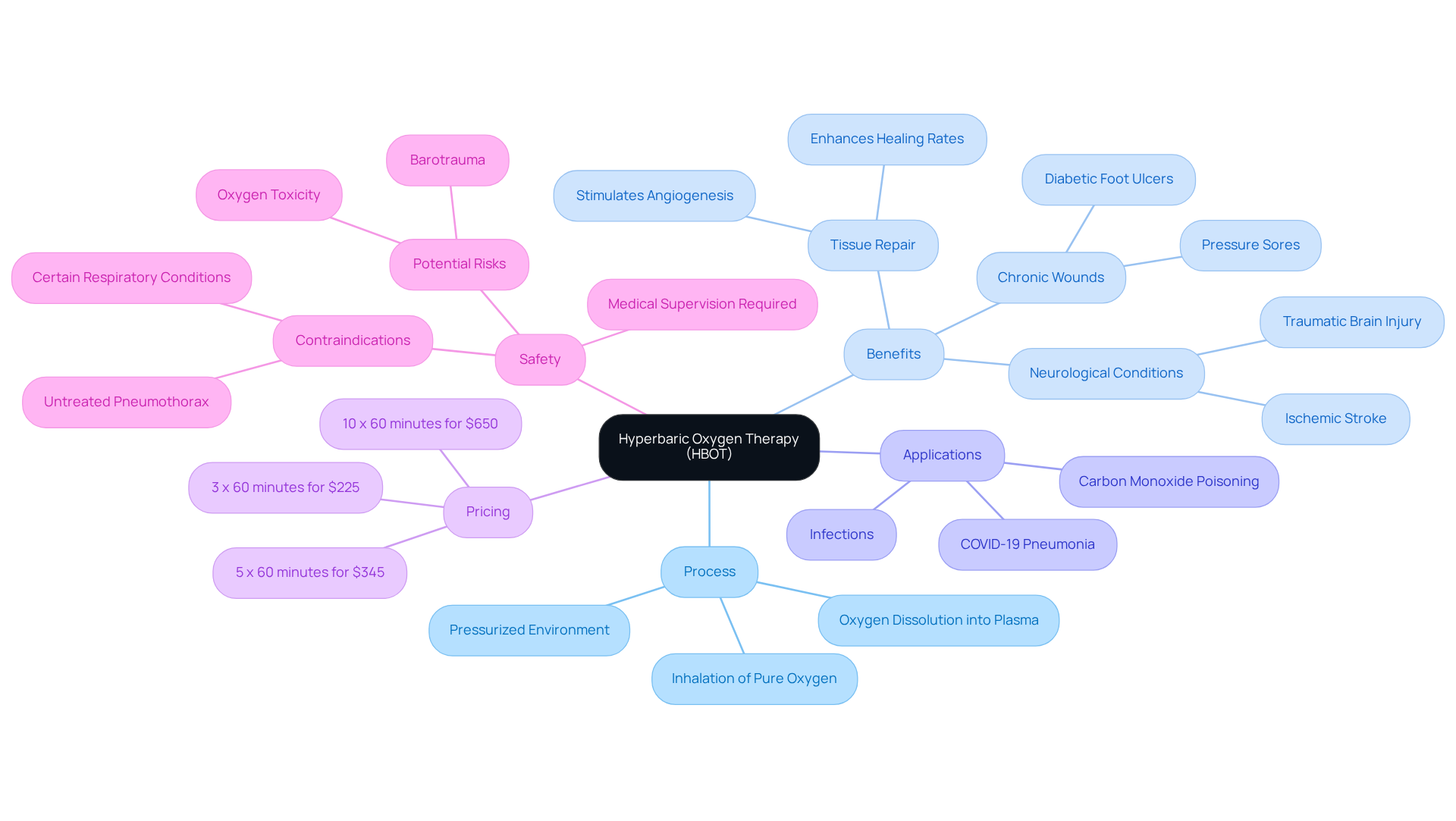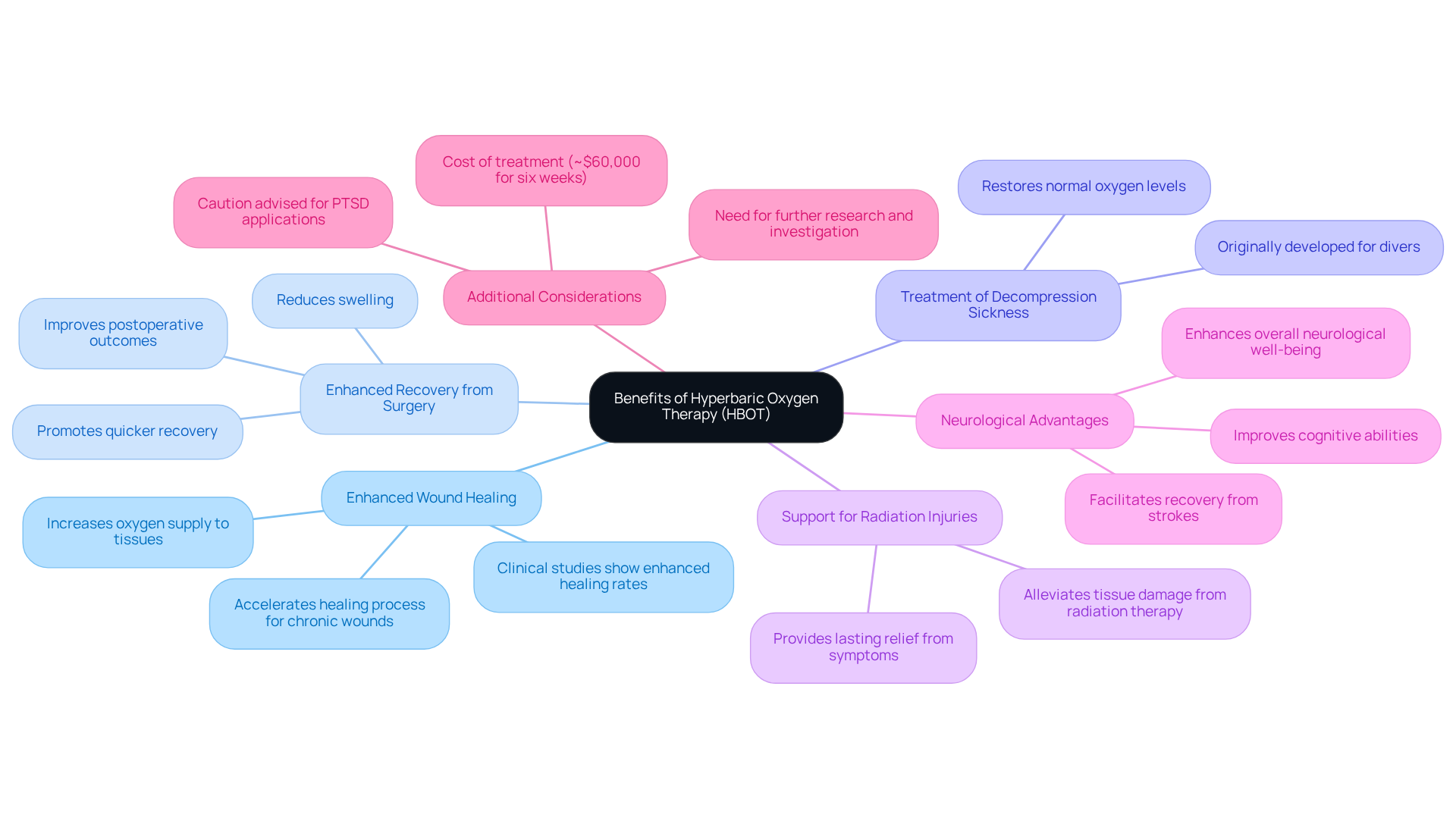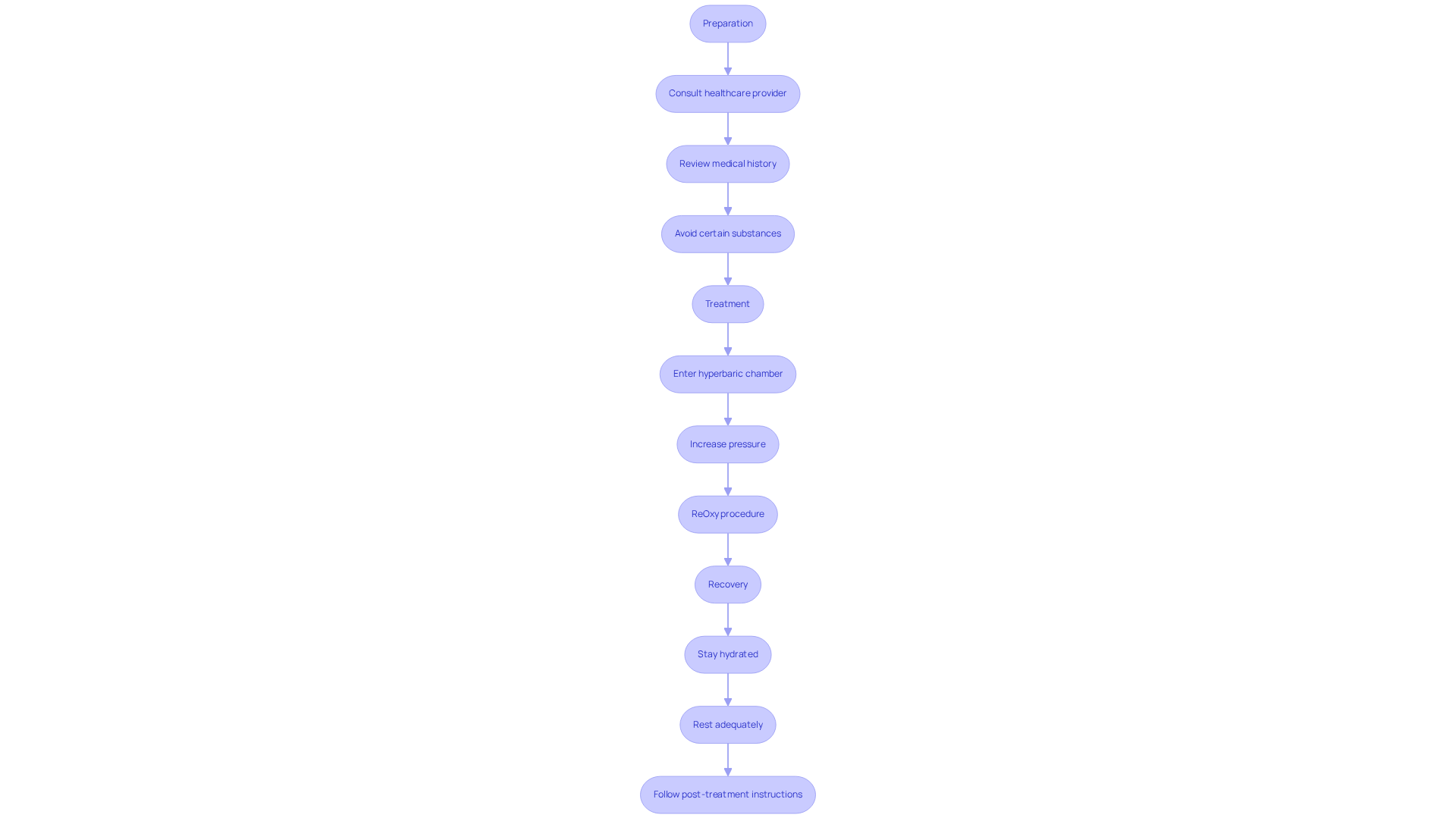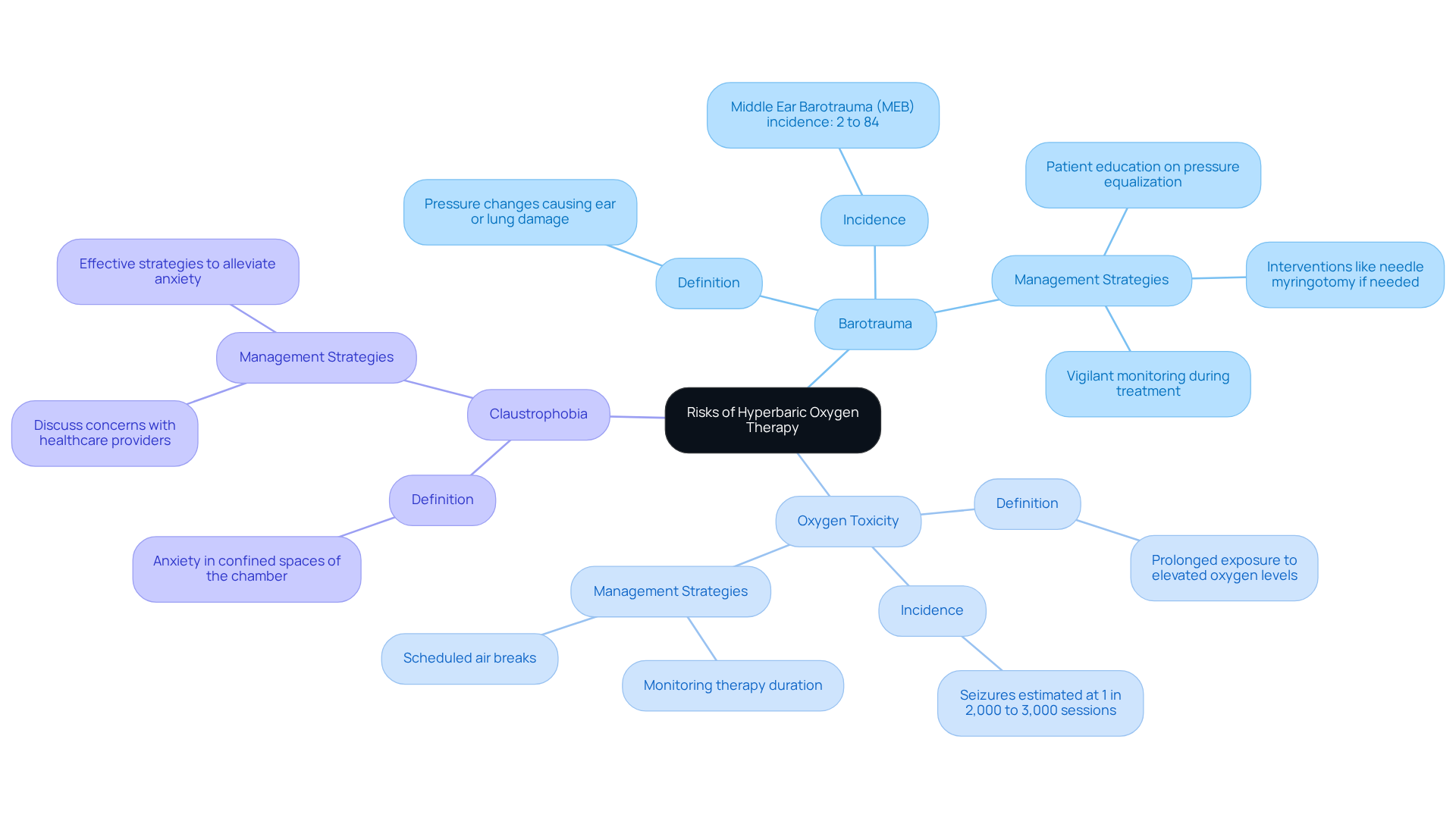Master HBOT: A Comprehensive Guide to Benefits and Safety

Overview
This article provides a comprehensive overview of the benefits and safety considerations associated with Hyperbaric Oxygen Therapy (HBOT). It is essential to recognize that HBOT can significantly enhance healing and recovery for various medical conditions, a fact supported by clinical research. Furthermore, the importance of medical supervision cannot be overstated, as it helps mitigate risks such as barotrauma and oxygen toxicity. As we delve deeper into the implications of HBOT, it becomes clear that understanding both its advantages and safety measures is crucial for maximizing its therapeutic potential.
Introduction
Hyperbaric Oxygen Therapy (HBOT) represents a cutting-edge approach in medical treatments, leveraging the power of pure oxygen in a pressurized environment to accelerate healing and recovery. This innovative therapy significantly enhances oxygen delivery to tissues and stimulates essential processes such as angiogenesis.
Consequently, HBOT emerges as a promising solution for a range of medical conditions, including chronic wounds and neurological injuries. However, understanding the intricacies of HBOT—its benefits, preparation, and potential risks—is crucial for maximizing its effectiveness and ensuring patient safety.
As patients explore the transformative potential of hyperbaric oxygen therapy, it is imperative to consider the associated challenges and factors that may influence their treatment journey.
Explore the Fundamentals of Hyperbaric Oxygen Therapy
HBOT, or Hyperbaric Oxygen Therapy, represents a cutting-edge medical treatment that involves inhaling pure air in a pressurized environment. This process significantly enhances the gas-carrying capacity of the blood, which is crucial for promoting healing and recovery, particularly in tissues suffering from gas deprivation due to injury or illness. At Tsavo Wellness, our advanced AirPod mHBOT chambers increase atmospheric pressure to 1.3ATA, facilitating oxygen dissolution into plasma and effectively delivering it to affected tissues, thereby enhancing the body’s natural healing processes.
The principles underlying hyperbaric oxygen therapy center on its ability to stimulate angiogenesis—the formation of new blood vessels—which is vital for tissue repair. Research indicates that hbot can enhance healing outcomes for chronic wounds, infections, and even neurological conditions. For example, it has demonstrated notable effectiveness in treating diabetic foot ulcers, with a significant percentage of patients reporting enhanced healing rates. Moreover, hbot has been explored for its potential benefits in managing conditions such as ischemic stroke and traumatic brain injury, where it may help prevent neuronal death by reducing inflammation and enhancing blood circulation.
At Tsavo Wellness, we offer a range of hyperbaric oxygen therapy packages:
- 3 x 60 minutes for $225
- 5 x 60 minutes for $345
- 10 x 60 minutes for $650
Each 60-minute session provides benefits equivalent to consuming 60 liters of hydrogen-infused water, promoting rapid and effortless health improvements. Administered under stringent medical supervision, this therapy ensures safety and efficacy while minimizing risks such as barotrauma and oxygen toxicity. This careful oversight is essential, as the are maximized when tailored to each patient’s individual needs and circumstances.
It is also important to note that hyperbaric oxygen therapy is recommended for conditions like carbon monoxide poisoning and has shown promising results in treating COVID-19 pneumonia. However, certain contraindications exist, including untreated pneumothorax and specific respiratory conditions, which must be assessed by healthcare professionals prior to treatment. Integrating insights from healthcare experts can enhance understanding; for instance, Dr. John Doe, a leading authority in hyperbaric medicine, asserts, "Hyperbaric therapy not only improves gas delivery but also modulates inflammatory responses, making it a powerful tool in modern medicine." Discover the transformative benefits of hyperbaric oxygen therapy at Tsavo Wellness, where we prioritize your health and well-being.

Discover the Proven Benefits and Approved Uses of HBOT
Hyperbaric Oxygen Therapy (HBOT) presents a multitude of significant health benefits that warrant attention:
- Enhanced Wound Healing: HBOT markedly increases oxygen supply to tissues, thereby accelerating the healing process for chronic wounds and injuries. Clinical studies indicate that individuals undergoing HBOT experience enhanced healing rates, with a meta-analysis revealing a substantial positive impact on wound recovery.
- Enhanced Recovery from Surgery: Patients undergoing surgical procedures can greatly benefit from HBOT, as it helps reduce swelling and promotes quicker recovery. Research substantiates the efficacy of HBOT in improving postoperative outcomes, leading to shorter recovery times.
- Treatment of Decompression Sickness: Initially developed for divers, HBOT effectively addresses decompression sickness, a condition that arises from rapid ascent from deep water, by restoring normal oxygen levels in the body.
- Support for Radiation Injuries: Patients who have undergone radiation therapy often experience significant tissue damage, which can be alleviated by HBOT. Studies have shown that HBOT therapy provides associated with radiation-induced injuries, thereby enhancing individuals' quality of life.
- Neurological Advantages: Recent research suggests that HBOT therapy may facilitate recovery from strokes and traumatic brain injuries by improving gas delivery to the brain. Clinical findings indicate notable enhancements in cognitive abilities and overall neurological well-being among patients receiving HBOT.
Beyond these benefits, the Airpod Hydroxy therapy at Tsavo Wellness enriches the overall experience by saturating the body with hydrogen and oxygen, further supporting recovery and well-being. Regular sessions can assist in detoxification, reduce inflammation, and enhance cellular health, establishing it as a vital component of your wellness toolkit. These advantages are corroborated by clinical research, prompting leading health authorities to endorse HBOT for specific medical conditions, thus reinforcing its significance as an essential treatment option. However, it is crucial to acknowledge that a six-week course of hyperbaric oxygen therapy may incur costs around $60,000, representing a considerable investment for patients. Additionally, caution is advised regarding the application of hyperbaric oxygen therapy for PTSD, as further research is necessary to fully understand its implications in this area. Expert insights, such as those from Dr. Wainwright, highlight the need for continued investigation into the therapy's applications and limitations.

Navigate the HBOT Process: Preparation, Treatment, and Recovery
The hbot process encompasses three critical stages that are essential for [optimal treatment outcomes](https://b86a40-56.myshopify.com/blogs/mind-body-wellness/10-benefits-of-private-massage-services-in-sydney-for-executives).
- Preparation: Prior to undergoing treatment, individuals must engage in a thorough consultation with a healthcare provider to evaluate their suitability for hbot. This assessment typically includes a physical examination and an extensive review of the individual's medical history. It is imperative to discuss any medications currently being taken, as certain drugs may need to be avoided to ensure maximum safety and efficacy. Additionally, individuals are strongly advised to abstain from tobacco and alcohol in the days leading up to the session. Patients should also arrive devoid of lotions, perfumes, cosmetics, and other prohibited items to uphold safety during treatment.
- Treatment: During the hbot session, individuals enter a hyperbaric chamber, which can be either a monoplace (single-person) or multiplace (multiple-person) unit. The chamber's pressure is gradually increased, allowing individuals to inhale pure air for a duration that typically ranges from 30 minutes to two hours. The ReOxy procedure enhances this experience by incorporating a , where individuals inhale a gas mixture with reduced oxygen levels to tailor the care to their specific needs. This procedure alternates between low and high oxygen concentrations, resembling the effects of high-altitude climbing, which trains and fortifies the body. This method is particularly beneficial for individuals undergoing rehabilitation, those with metabolic disorders, and those seeking preventive and anti-aging therapies.
- Recovery: Following treatment, individuals may encounter mild side effects such as ear discomfort or fatigue, which are generally manageable. It is crucial to stay hydrated and allow for adequate rest after the session to facilitate recovery. Adhering to any post-treatment instructions provided by hyperbaric technologists is essential for ensuring effective recovery. Regular follow-up appointments may be scheduled to monitor progress and make necessary adjustments to the treatment plan, ensuring individuals receive the most effective care tailored to their needs. It is vital to note that the ReOxy procedure should not be conducted in cases of acute cerebrovascular episodes, ischemic heart disease, heart failure, COPD, or significant respiratory disorders, necessitating prior consultation with a physician for individuals with such conditions.

Understand the Risks and Safety Precautions of HBOT
hbot, or Hyperbaric Oxygen Therapy, is widely recognized for its safety; however, understanding is crucial for informed decision-making.
- Barotrauma is a significant concern, resulting from pressure changes that can harm the ears or lungs. The incidence of middle ear barotrauma (MEB) in patients undergoing hbot varies dramatically, with reports ranging from 2% to 84%. Effective management strategies, including patient education on pressure equalization and vigilant monitoring during treatment, are essential to mitigate this risk. In severe instances, interventions such as needle myringotomy may be required for those unable to equalize ear pressure.
- Oxygen Toxicity poses another risk; prolonged exposure to elevated oxygen levels can lead to toxicity impacting both the lungs and central nervous system. The estimated occurrence of seizures due to oxygen toxicity during hbot is approximately 1 in 2,000 to 3,000 sessions. To prevent this, the duration of therapy is meticulously monitored, and preventive measures, such as scheduled air breaks, are implemented.
- Claustrophobia can also affect some patients, as anxiety may arise in the confined space of the chamber. It is advisable to address any concerns with healthcare providers prior to treatment, as they can offer effective strategies to alleviate anxiety.
To ensure safety during hyperbaric oxygen therapy, it is imperative to receive treatment under the supervision of skilled professionals who can manage the procedure and address any complications that may arise. Patients must provide a comprehensive medical history to identify any contraindications for hbot treatment. Adhering strictly to the manufacturer's instructions and safety guidelines is vital to minimize the risks associated with this therapy.

Conclusion
Hyperbaric Oxygen Therapy (HBOT) emerges as a groundbreaking treatment option that significantly enhances the body's healing capabilities through the inhalation of pure oxygen in a pressurized environment. This therapy not only facilitates the recovery of chronic wounds and injuries but also presents promising results for various medical conditions, including neurological disorders. By increasing oxygen delivery to tissues, HBOT plays a vital role in promoting overall health and well-being.
Key insights into the benefits of HBOT have been emphasized, including:
- Its capacity to accelerate wound healing
- Improve recovery from surgery
- Alleviate symptoms associated with radiation injuries
Furthermore, the structured process of preparation, treatment, and recovery guarantees that patients receive safe and effective care tailored to their individual needs. Acknowledging the potential risks, such as barotrauma and oxygen toxicity, along with the necessary safety precautions, underscores the importance of professional supervision during therapy.
The transformative potential of HBOT is profound. As more individuals pursue effective solutions for their health challenges, embracing advancements in hyperbaric medicine may lead to significant enhancements in quality of life. Engaging with healthcare professionals and considering HBOT as part of a comprehensive treatment plan can pave the way for improved recovery and well-being.
Frequently Asked Questions
What is Hyperbaric Oxygen Therapy (HBOT)?
Hyperbaric Oxygen Therapy (HBOT) is a medical treatment that involves inhaling pure oxygen in a pressurized environment, which enhances the gas-carrying capacity of the blood and promotes healing, particularly in tissues affected by gas deprivation due to injury or illness.
How does HBOT promote healing?
HBOT stimulates angiogenesis, the formation of new blood vessels, which is essential for tissue repair. It can improve healing outcomes for chronic wounds, infections, and neurological conditions.
What conditions can HBOT help treat?
HBOT has shown effectiveness in treating diabetic foot ulcers, ischemic stroke, traumatic brain injury, carbon monoxide poisoning, and has promising results for managing COVID-19 pneumonia.
What packages are offered for HBOT at Tsavo Wellness?
Tsavo Wellness offers the following HBOT packages: - 3 sessions of 60 minutes for $225 - 5 sessions of 60 minutes for $345 - 10 sessions of 60 minutes for $650
What are the benefits of a 60-minute HBOT session?
Each 60-minute session provides benefits equivalent to consuming 60 liters of hydrogen-infused water, promoting rapid health improvements.
How is HBOT administered?
HBOT is administered under strict medical supervision to ensure safety and efficacy while minimizing risks such as barotrauma and oxygen toxicity.
Are there any contraindications for HBOT?
Yes, contraindications for HBOT include untreated pneumothorax and specific respiratory conditions, which must be evaluated by healthcare professionals before treatment.
Who supports the use of HBOT in modern medicine?
Experts like Dr. John Doe, a leading authority in hyperbaric medicine, support the use of HBOT, noting that it improves gas delivery and modulates inflammatory responses, making it a powerful therapeutic tool.


